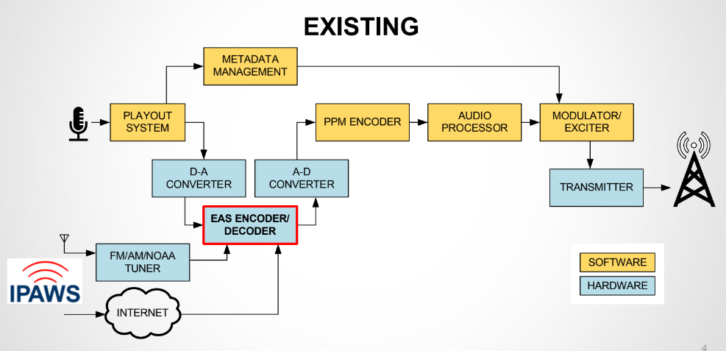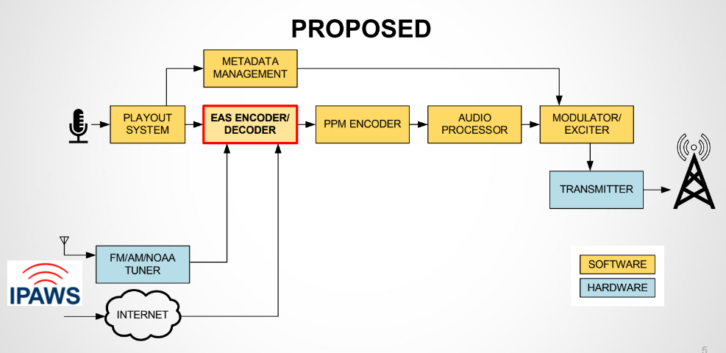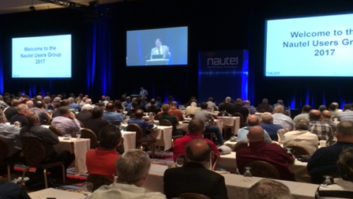Representatives from the NAB and several of the largest radio groups in the United States met recently with FCC officials to discuss how software-based EAS encoder/decoder technology could replace physical hardware equipment boxes at radio stations.
NAB says the solution it is proposing would further the FCC’s goal of helping broadcasters secure their alerting equipment from cyberattack. The early April meeting included a chat about the possible architecture of the software-based approach and the safety benefits that would result, according to a recent NAB Ex Parte filing.
The broadcast representatives included NAB technical staff members, Steve Shultis of New York Public Radio, Alan Jurison of iHeartMedia and Roswell Clark of Cox Media Group. Discussions centered on the FCC’s current proposed rulemaking to enhance the security and reliability of EAS. The NAB emphasizes that its proposal would be voluntary in providing EAS participants the option to virtualize certain elements of their alerting systems. During the meeting, the parties stressed this voluntary aspect. EAS participants would be free to continue using hardware encoder/decoder boxes and receive the manufacturer-provided services attached to such boxes.
If parties wanted to adopt NAB’s proposed option, however, they would unlock a number of benefits, NAB told the FCC.

Allowing broadcasters to virtualize certain elements of EAS would enhance the security, operational readiness and resiliency of the system, NAB believes.
The association says it recently met with officials from the Federal Emergency Management Agency and that, after a detailed discussion of the proposal, the “FEMA IPAWS staff offered a clear endorsement of NAB’s proposal to modernize EAS and encouraged us to make the FCC aware of their position,” according to the NAB.
For virtualization to work, NAB says any new software encoder/decoder products would have to function seamlessly within the existing EAS system and have no negative impact on baseline EAS operations. “[At the meeting] we discussed options for the testing and certification by vendors of such software in only certain servers or systems, similar to the process used for many other software products used in the broadcasting industry, such as Nielsen PPM ratings watermarking software.”
NAB continued: “We also noted that, regardless of the specific configuration or equipment used, EAS operations will remain subject to weekly, monthly,\ and nationwide periodic tests that will detect problems and help ensure functionality.”
The proponents of EAS virtualization cite several benefits for broadcasters:
- Reducing or eliminating the down-time currently needed to repair malfunctioning equipment
- Reducing the time needed to install security-related software patches
- Enable the immediate failover to standby equipment if needed
- Allow the use of redundant, geographically diverse locations of encoder/decoder operations in cases of extreme disasters. We also explained that a virtualized approach could help improve overall EAS system monitoring, data collection, and visibility into operational readiness.
The NAB says it is not advocating for a fully cloud-based approach. “We stated that such a virtual option would provide EAS participants with more flexibility to simplify their facilities. In this vein, we clarified that the baseline proposal contemplates the creation of autonomous software-based EAS functions located at the edge of a broadcaster’s operation, similar to other systems used in modern frameworks. Like today’s legacy EAS hardware boxes, a software-defined EAS mechanism at the broadcaster’s edge would still operate if internet or cloud connectivity is interrupted.”

EAS equipment Digital Alert Systems earlier had filed comments with the FCC saying virtualization of EAS equipment could risk weakening local and national EAS.
NAB told the FCC it is “agnostic” regarding the development of EAS software. The association says it would anticipate and prefers current EAS equipment vendors lead the effort “because this would allow industry to reap the benefits of their experience and expertise in this somewhat niche area of technology.”
Comments in the FCC’s EAS cybersecurity proceeding (PS Docket No. 22-329) can be read here.










